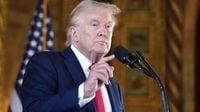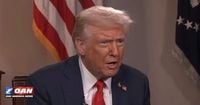As the United States entered October 2025, the nation found itself at the crossroads of fiscal turbulence and political drama. President Donald Trump, never one to shy away from headline-grabbing proposals, floated the idea of sending Americans $1,000 to $2,000 rebate checks—funded not by traditional stimulus or borrowing, but by the billions collected from his sweeping tariffs on foreign imports. The move, which Trump dubbed a "dividend to the people of America," comes just as the Supreme Court prepares to weigh in on the very legality of the tariffs underpinning this bold promise.
The partial government shutdown, which began on October 1 after Congress failed to pass a funding deal, set the stage for heightened tension in Washington. Essential services continued, but the specter of job losses and canceled projects loomed. President Trump, speaking to the One America News Network on October 2, did not mince words: “There could be firings, and that’s their fault,” he said, placing the blame squarely on congressional Democrats. “We could cut projects that they wanted, favorite projects, and they’d be permanently cut. I am allowed to cut things that should have never been approved in the first place and I will probably do that.”
Yet, even as the shutdown threatened federal workers and public services, Trump pivoted to a more populist message—one that could prove politically potent. “We also might make a distribution to the people, almost like a dividend to the people of America,” he told OAN. “We’re thinking maybe $1,000 to $2,000. It’d be great.” According to The New York Post and Fox Business, the president’s plan would use revenues generated from what he calls "Liberation Day" tariffs, which have been imposed on a range of foreign goods since April 2025.
Trump’s confidence in the financial windfall from tariffs is nothing short of grandiose. “They’re just starting to kick in,” he said, predicting that "ultimately, your tariffs are going to be over a trillion dollars a year." He argued that these revenues would allow the government to pay down the national debt—now hovering around $37 trillion, which he described as “very little, relatively speaking.” Trump asserted, “Number one, we’re paying down debt, because people have allowed the debt to go crazy.” But he added, “With that being said, we’ll pay back debt, but we also might make a distribution to the people.”
His estimates, however, far outstrip those of his own Treasury Secretary, Scott Bessent. According to Bessent, customs duty revenues from the tariffs could top $500 billion a year—a remarkable sum, but only half of Trump’s trillion-dollar projection. Treasury Department data shows that, so far in 2025, the U.S. has collected approximately $214.9 billion in tariffs, with $31.3 billion coming in September alone. Bessent expects that figure to reach at least $300 billion by the end of the year.
The idea of a "tariff dividend" is not without precedent—stimulus checks were a hallmark of the COVID-19 era—but the funding source this time is novel. Trump’s administration contends that the tariffs, which essentially act as taxes on foreign goods, have created a pool of money that could be redirected to ordinary Americans. But there’s a catch: any such distribution would require congressional approval, a tall order in the current climate of partisan gridlock.
Legal clouds also hang over the president’s tariff regime. The U.S. Court of Appeals for the Federal Circuit ruled in August that most of Trump’s tariffs were not covered by existing emergency powers laws, echoing similar findings from two lower courts. For now, the appeals court has allowed the tariffs to remain in place while the case moves forward. The Supreme Court is set to hear arguments in early November that will determine whether the president has the authority to impose such sweeping duties.
The stakes are high. Bessent has warned the justices that, should the Supreme Court find the tariffs illegal, the government could be forced to refund between $750 billion and $1 trillion in collected and projected tariff revenue. That’s not just a bureaucratic headache—it could blow a gaping hole in the federal budget, upending Trump’s plans and potentially triggering economic fallout.
Meanwhile, the tariffs themselves have had global repercussions. On August 27, the U.S. imposed a 50% tariff—including a 25% penalty for buying Russian oil—on exports from India. The move has hit labor-intensive sectors such as shrimp, textiles, leather, and footwear particularly hard. In a further escalation, Trump announced a 100% tariff on all imported branded and patented medicines unless the manufacturer is building production facilities in the United States. Announcing the measure on social media, Trump declared, “The United States would impose a 100% tariff on any branded or patented drug unless a company IS BUILDING their Pharmaceutical Manufacturing Plant in America.” He defined this as “breaking ground and/or under construction.”
Despite the shutdown, some vital government functions continue. As reported by The Express and other outlets, U.S. Customs has kept up tariff collection and cargo inspections, and the Treasury Department remains active in enforcing sanctions. In other words, the financial engine behind Trump’s rebate proposal keeps humming, even as much of the government is idled.
For Trump’s supporters, the rebate checks represent a tangible benefit from his confrontational trade policies—a way to share the spoils of "America First" economics with ordinary citizens. For critics, the plan is little more than a political gambit, built on shaky legal ground and questionable economic logic. Many economists warn that tariffs, while raising revenue for the government, also increase costs for consumers and can trigger retaliation from trading partners, ultimately hurting American businesses and workers.
And there’s the matter of the national debt. While Trump insists that the influx of tariff revenue makes the $37 trillion debt “very little, relatively speaking,” most fiscal experts would beg to differ. The debt remains a major concern for policymakers on both sides of the aisle, and the idea that tariffs alone could solve the problem is, at best, optimistic.
As the Supreme Court prepares to hear arguments in November, the fate of Trump’s tariffs—and the promised “dividend to the people”—hangs in the balance. If the justices uphold the president’s authority, Americans might indeed see rebate checks in their mailboxes. If not, the government could be on the hook for hundreds of billions in refunds, and Trump’s signature trade policy could unravel almost overnight.
For now, the nation waits. Will Americans receive a windfall from tariffs, or will the courts pull the rug out from under this ambitious plan? One thing is certain: the intersection of trade, law, and politics has rarely felt more consequential—or more unpredictable.

